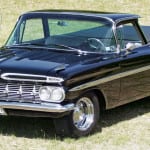Is there one standard the automotive industry prefers to use when gauging used vehicle pricing? For the most part, yes, there is. A layer of trust with Kelley Blue Book is mutual between shoppers and dealerships. But what exactly is Kelley Blue Book, how does it work, and who is this Kelley guy? These are all questions I’ll get to, but if you’re wondering, “How do I value my trade?” look no further than the old reliable KBB.
Kelley Blue Book has been a trusted source for estimating the value of your current vehicle for years. Alternatively, if you’re looking to research the value of a car you wish to purchase, Kelley Blue Book is a de facto choice. But before I go into how the trade values work and what goes into the estimate, let’s first discuss the history of Kelley Blue Book and how it ultimately came to be.

History of KBB
Long ago—and I mean long ago—there lived a man named Les Kelley. How far back in time? The year was 1918, four years before the release of “The Little Rascals” and “The Three Stooges.” To say the automotive industry was still in its infancy would be an understatement.
Les Kelley ran a dealership alongside his brother, Sidney, in Downtown Los Angeles. The first Kelley Car Company dealership was at 1834 South Figueroa Street. Originally dubbed the Kelley Car Company, Les Kelley’s business was visionary for many reasons.
To differentiate the Kelley Car Company from each of its competitors, the Kelley brothers made a peculiar business decision to apply new paint to vehicles. This may seem trivial today, but at the time, this was ingenious. Aside from vehicle sales, Les Kelley began utilizing his knowledge of the bustling pre-owned vehicle market to categorize the vehicles by what he considered their worth—based on a handful of market factors and conditions.
Pre-owned vehicles were where the Kelley brothers’ business began, and the first release of Kelley Blue Book reflected this. The automotive industry wasn’t the only market to utilize a price guide; it was common back then and is especially common today. Naming your price may be the way it’s done at events like a yard sale if discussing an old vase or a random piece of furniture, but items of high value tend to get more specific price tags. Sports cards have had their prices evaluated for years, and the best example of this is the Beckett Card Price Guide shipped annually to give collectors an updated list of their beloved sports cards in hopes of purchasing low and selling at a high.
A price guide is crucial to have in any industry, and in the automotive industry, those looking to flip vehicles on the market are likely to keep track of their highest and lowest prices. Alternatively, those looking to purchase a car and aren’t sure if they’re getting a scam rather than a sale can use Kelley Blue Book to ensure they’re getting the right deal.
Something that makes Kelley Blue Book more trustworthy than other price guides is its consistent legacy. The first official Kelley Blue Book pricing guide launched in 1926, only eight years after the Kelley brothers opened their pre-owned automotive dealer. The success this brought to the Kelley brothers was significant, and Kelley became a household name during the 1930s and 1940s. If you were in Los Angeles in the 1920s, 30s, 40s, or 50s and needed a pre-owned vehicle, then there wasn’t any question about it: you would go to the Kelley Car Company. Because of the immense success, its Kelley Blue Book Pricing Guide found, customers could trust they were getting a good deal.
The follow-up location for the Kelley brothers’ dealership wasn’t far away—at 1225 South Figueroa Street, Los Angeles, essentially down the street from the previous one. Kelley Blue Book would become a standard, and if you were purchasing a vehicle, the first people you’d want to check with were the Kelleys and their signature book. Eventually, Kelley Blue Book’s aging pre-owned pricing guide would sit alongside a guide for brand new vehicles, which marked a shift in the original business model used since 1918.
Keeping Up with the Times
Kelley Blue Book has never rested on its laurels, and whenever an opportunity has come knocking, Kelley Blue Book has been there. In the early 1990s, while many were struggling to adapt to the rise of the world wide web, KBB took action. As a company that started with just paper, you’d think they’d have a lot to overcome to shift towards the digital age. But KBB became a digital star. Kelley Blue Book’s official website launched in 1995, only four years after the first ever website went online in 1991.
Sadly, Les Kelley passed away in 1990 and never got to see his company become a digital powerhouse. The Kelley Blue Book website’s popularity is undoubtedly thanks to the pre-established fanbase the pricing guide had accrued since its launch in the 1920s. Some things have not changed though, thanks to the careful planning and consideration of the Kelley brothers as they built their company. Today, millions rely on KBB’s website to provide them with reliable pricing information. The only thing that has changed is how we obtain that information.
There’s a chance you’ve been to the Kelley Blue Book website in the past or recently. If you weren’t on the internet, you wouldn’t be reading this article, and what many of us tend to forget is how great it is that we can do research without picking up a magazine, going to the library, etc. According to the Pew Research Center, only 18 million households had internet-capable computers in 1995, but that didn’t mean everyone with these computers accessed the internet. Based on Pew Research Center’s findings, 97% of Americans hadn’t utilized the internet in 1995, based on its report that 3% of Americans had done so. Why do I bring this up? Even before the internet became ingrained in our daily lives, Kelley Blue Book was there, ready to give you accurate vehicle pricing from the minute each household connected online for the first time.
How Does It Work?
While it may seem like magic, Kelley Blue Book’s value estimations aren’t too complicated. To get the most accurate pricing available, you need pricing set by real-world drivers. To get the most accurate data on pre-owned vehicles sold, Kelley Blue Book keeps track of the final selling prices for each automobile, whether from your local dealership, an auction, etc.
Keeping track of pricing is one of the most well-known ways Kelley Blue Book ensures accurate values annually, but other factors play a hand too. For example, if a particular vehicle gets discontinued, older models begin to see a price increase. Changes like this will show on the pricing guide released the following year.
Using real-world data to publish a pricing guide is a crucial aspect of what makes Kelley Blue Book a trusted resource. Kelley Blue Book is not a business trying to create artificial demand for various pre-owned vehicles. If a car is becoming pricier or cheaper in the real world for any reason, Kelley Blue Book will catch wind of it. Regardless, it’ll be updated accordingly, helping Kelley Blue Book keep up its status as a worldwide choice for estimating the value of your vehicle.





